
Kansas City had its first snow of the season this week. Normally Winter weather doesn’t hit us for several more weeks, but 2020 just keeps throwing punches. Despite seeing snow annually, the first few of the year always seem to make people forget how to drive. Even with only an inch or two on the ground, local Law Enforcement responded to over 4x the amount of crashes in a 24 hour time period compared to the previous week. Over 100 involved injuries, making up over 50% of the accidents. With the potential to be stuck in inclement weather, we need to be preparing for the worst. Here are some suggestions for your vehicle’s Winter emergency kit.
A Well Maintained Vehicle
The most important thing you can do is have a vehicle that is in good shape. Tires with solid tread, anti-freeze fluids, a full gas tank, and more. Keeping your vehicle well maintained should help prevent most accidents and emergencies. At the very least this can help reduce the impact if you become stranded, waiting for help to arrive.
This isn’t a comprehensive list, but verifying the status of the following is a good start:
- Headlights, turn signals, emergency flashers
- Heater and defrosters
- Windshield wipers and fluid (with non-freezing fluid)
- Brakes and brake fluid
- Oil levels
- Tire pressure and tread condition
- Anti-freeze and radiator
Know How to Change A Tire
Knowing how to change a flat tire is an important skill to have year round. This will pay even greater dividends during foul weather. Changing tires will keep you on the road and save you an expensive service call for something that anyone should learn when they turn 16. Make sure your vehicle has a functional jack and wrench with it, otherwise that knowledge is virtually useless.
If you’ve modified your vehicle with a lift, drop, or aftermarket wheels, you’ll want to verify that your factory equipment works with your mods. Often these changes can cause incompatibility, and you don’t want to learn that on the side of the road.
Ice and Snow Scrapers
Leave your car outside for any amount of time and you’ll likely build up some snow and ice on your windshield and windows. Using your windshield wipers can damage the blades and potentially break the mechanism if they’re frozen to the car. Waiting for the glass to defrost can take more time than we have available. With this in mind, we need a way to clean our cars quickly. This is when ice scrapers and snow brushes come in.
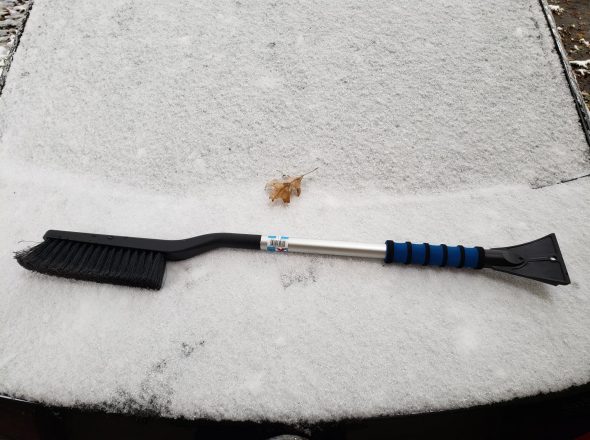
My preference are the long, two handed scrapers. These allow better leverage when breaking up thick ice, and provide better reach across the car. Additionally, they frequently have integrated snow brushes and other helpful features. Spending a little more money here can be beneficial as well, as you often get what you pay for. Having your gas station special snap in half with only a little work done is never a good situation to be in.
Emergency Food and Water
As the Mad God Sheogorath says, “Drink water, drink water, drink water…”. Most folks are bad enough about staying hydrated during the Summer, even with the heat telling them to do so. This is usually worse in the Winter, as people think being cold means they don’t have to hydrate as well. This can result in some nasty physical and psychological side effects which can impair your ability to drive and handle other stressors.
If you get stranded while driving, it may take hours for help to arrive. Emergency services will not only be moving slower in bad weather, but they’ll be increasingly busy with all the other weather induced accidents. Not to mention some areas that are experiencing budget shortfalls thanks to reduced tax revenue and re-taskings in our current environment. Being able to keep yourself hydrated and fed while waiting for help will reduce your anxiety and improve comfort. Keeping some toilet paper around might be handy as well depending on how long you end up waiting.
A gallon of water is inexpensive and sits nicely on a floorboard. Military rations (MREs), and other non-perishable foods like protein bars can last for months while providing tons of calories. Junk food is fun, but we all know that fails to provide anything filling or fulfilling.
Signaling Devices
If we’re stranded on the side of the road we need to alert others to our presence. This serves two purposes. First, to draw attention to emergency responders. Getting passed by those trying to help you will be a blow to your morale, besides extending the time you’re stranded. Additionally, we want to ensure safe separation from oncoming traffic. Nothing is worse than an emergency situation being compounded by a follow-on accident.
Many new cars come with some sort of signaling device in a small kit. My vehicle has a small, folding, reflective triangle which can be placed on the ground or on the trunk/hood. Other options include flags which can be tied to the vehicle, and glowsticks/chem lights for use in the dark. Reflective materials will be useful in all weather conditions, and will likely be visible at further distances than chem lights, so keep that in mind when making your selection.
Another excellent option is the road flare. These can be bought by anyone and will be the most visible option by a wide margin. Useful in all weather conditions, with the added advantage of providing a good light source for you. Use caution, as road flares can cause fires in dry conditions. I recommend placing them on the roadway, hence the name. Burn times vary between 5 to 30 minutes depending on model.
Blankets and Warm Clothing
Many people scoff keeping warm clothing or blankets in their vehicles. As a teenager, I was known to wear shorts and short sleeves in below freezing weather in some misguided display of toughness. Why bring along these things when we’re going from our home to an indoor destination, with a functioning heater in our car? What if that heater goes out while driving or as a result of an accident? We may soon be learning the error of our ways.
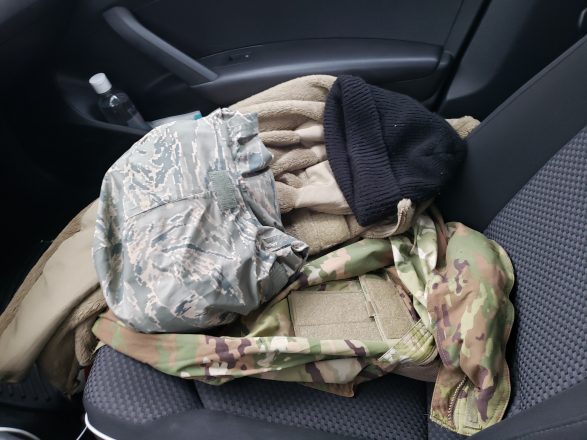
Blankets can be had for just a few dollars and pay dividends when needed. Folding or rolling them can substantially reduce the space required for storage. A small space blanket can fold up to the size of a large wallet, while still being effective.
A change of clothes (socks, pants, shoes, shirt, coat) can also be helpful in the event you have to leave your vehicle. Whether you’re changing tires, pushing the car from the road or from a ditch, or running for help. Being able to shed your wet and cold clothes for a fresh set can be a literal life saver. At the very least, keeping a waterproof coat or poncho can reduce the unpleasantness of the season.
Emergency Escape Tools
Those of us who have been in or around wrecks know that leaving the vehicle is not always a simple task. This is made worse if your vehicle tumbles into a body of water. I pass over several large creeks and near ponds during my commute, making this a real possibility. The ability to cut yourself free of a seatbelt and break windows could be the difference between life and death. These can also be useful in the event you come across someone else in need of help.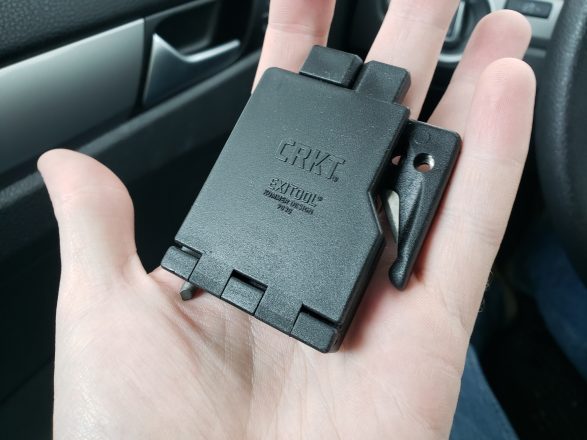
I personally use the CRKT Exitool, clasped to my seatbelt. This combines both a seatbelt cutter and glass breaker in one compact package. I previously used a (discontinued) Gerber strap cutter, which I later gave to my sister. Many gas station knives include these features, but going with something from a reputable company will likely be a better bet. A dedicated strap cutter will also reduce the likelihood of accidentally cutting yourself under stress.
Light Source
During Winter more than half our day is spent in darkness. Clouds, snow, and other factors only serve to decrease usable light and visibility. With this in mind, we need to have our own way of producing light. I keep a flashlight on my person at all times, but also keep a few lights in my car for emergency use. For vehicle use, I prefer a light that is chargeable, either using a power converter, or directly plugged into the cigarette lighter.
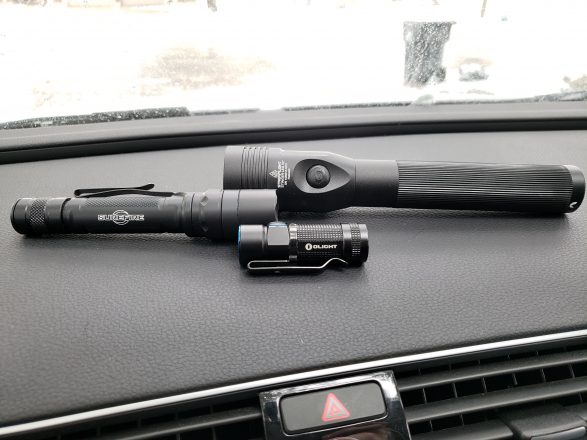
While I’m not a big fan of Olight, I do keep a S1R Baton II in my center console for emergencies. Its magnetic back size allows it to be attached to various metal surfaces, freeing up both hands. Reliability has been an issue, but it’s never my only light source. I also keep a Streamlight Stinger in my car for higher performance and better reliability. Both lights feature various brightness settings and can charge via AC or DC means. A solid headlamp is also an excellent option as well.
First Aid Kit
When talking about emergencies and traffic accidents, injuries are always possible. Knowing how to treat various injuries and having the proper equipment to do so can be a life safer. Not everyone needs to have paramedic level expertise, but some training can be helpful.
In my car I keep a small first aid kit. Inside I keep the following:
- CAT Tourniquet
- Hemostatic gauze
- Normal gauze
- Israeli bandage
- Band-aids (various sizes)
- Tylenol
- Anti-diuretics
- Antiseptic spray
- Burn relief spray
- Space blanket
- Chest seals (3x per pack)
Everything is kept in a small, plastic ammo can for easy carrying. Are there other, helpful items that could be included here? Certainly. I limit what I keep based upon my level of training, you won’t find decompression needles of NPAs in my kits. Years of SABC and CPR training is where my experience stops, and my kit is based off of that. Keeping items on hand to treat boo-boos as well as serious trauma will make for a well rounded kit. At the very least, I recommend keeping a tourniquet on hand for hemorrhagic bleeding.
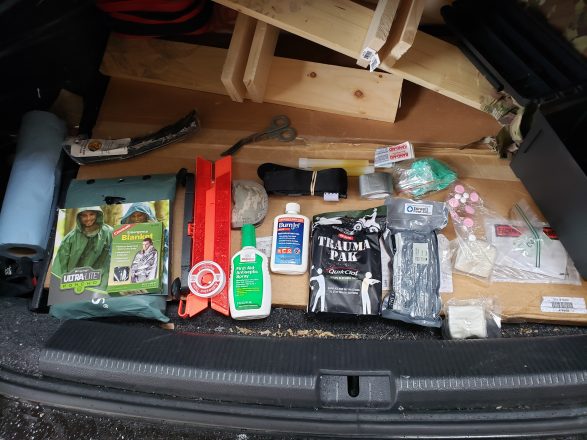
Jumper Cables
If your car won’t start, you’re not going anywhere. Often this comes from a dead battery, which can be quickly resolved with a jump from another vehicle. Like with anything else, there are varying degrees of quality, with cheaper options potentially failing when needed. Avoid jumper cables with soldered connections, as the solder can potentially melt during use.
Not to be a size queen, but longer is better in this realm. Longer cables mean you are not as restricted in how you arrange the vehicle jumping you. Whether there’s a height difference (truck to car), or limitations on space (shoulder of the road, etc), longer cables can allow you to jump from over the length of a car away. I keep mine in a drawstring shoulder bag for storage and easy transportation.
Make sure you know how to properly jump start a car as well. I cannot tell you how many times I’ve seen people who have cables, but no idea how to use them. At best, you’re stuck with the right tools waiting for help to arrive. At worst, you can damage your vehicle’s electronics and potentially cause your battery to explode.
Special Mentions
We could go on all day about other important items to have on hand. Unfortunately, many things are not within our budgets, or will not fit within the size constraints of our vehicles. Below are a few more items that can come in handy, but may be of lower importance than items above.
Fire Extinguisher
Cars don’t catch fire often, but it does happen. Often, proper vehicle maintenance can prevent fires, but this is not always the case. In this event, a fire extinguisher can prevent a total loss of your vehicle. Fire extinguishers come in several classes for use of various types of fire. Using the wrong kind can potentially worsen the effects of the fire.
- Class A: Standard combustibles– Non-metals. Wood, cloth, paper, etc
- Class B: Flammable and combustible liquids– Gasoline, grease, acetone, oil, etc
- Class C: Electrically energized fires — Batteries, outlets, etc
- Class D: Flammable Metals– Potassium, Magnesium, etc
If you need to use your fire extinguisher, remember the PASS method:
- P. Pull the pin
- A. Aim the fire extinguisher at the base of the fire
- S. Squeeze the handle of the fire extinguisher
- S. Sweep the nozzle from side to side, pointing at the base of the fire..
- If the fire re-ignites, repeat the last 3 steps.
Tools
A small toolbox can come in handy in a pinch. For the mechanically inclined, socket wrenches, electrical tape, and more can allow you to make minor repairs to your vehicle that would put the average person out of commission. Removable floor mats, sand, and a folding shovel can help you fight your way out of a ditch or snow embankment. The most simple addition, a tire pressure gauge, can help you stay on the road, staying ahead with your preventative maintenance.
Full Size Spare Tire
Virtually every car comes with some sort of spare tire. For trucks, SUVs, and other large vehicles, this is almost always a full size spare tire. Those of us with sedans, wagons, and similar, are often stuck with the rubber donut. These are from ideal, as the donut provides substantially inferior performance compared to a standard tire. This means that our challenging drive just got even more difficult. Most of us don’t have the spare room to store a spare, full size tire, but the ability to do so can make your life much easier down the road.
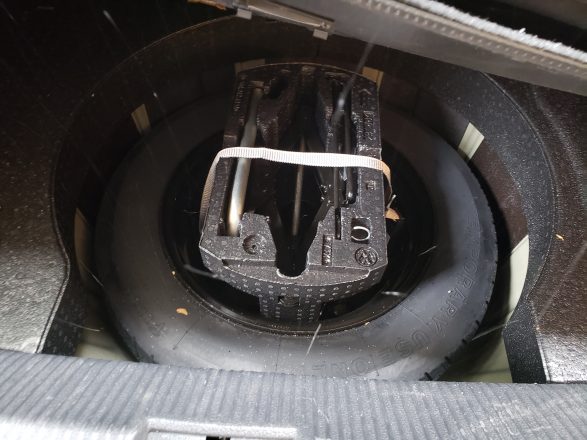
Often times trucks and SUVs leave their spare tires exposed to the elements, which can result in the decomposition of the tire over time. It may not be noticeable to the naked eye, but tires weaken, which can lead to another failure after your tire change. Be sure to regularly inspect your spares for damage.
Power Packs
Being able to call for help is one of the wonders of our digital age. Keeping yourself entertained until help arrives can make the time pass much more quickly. None of this matters if our phones and other devices die, and if you’re without a way to keep them powered, you’re out of luck. Keeping a dedicated car charger on hand should solve this problem 99% of the time, but even that won’t help if your car won’t start.
Spare battery packs should be a must-have for anyone. They can help when traveling, without power at home or abroad. Keeping them charged is a breeze, and some can provide multiple full charges for your phone.
Support My Work
If you made it this far, thanks for reading! Writing isn’t my full-time profession, and nearly everything I do comes out of my own pocket. Between ammunition, tuition, range fees and more, expenses add up fast. If you like what I have to offer, consider making a donation to my Patreon.
Every bit helps bring more work like this to you, and contributes to shortened timelines or more in-depth work on my part. You’ll also have more direct access to me, offering suggestions for future projects, looking behind the scenes, and getting early access to some content. You can find my Patreon >>HERE<<


Another point to add to everything above: Make sure the spare tire in your vehicle actually has air in it.
Excellent article on the important things to supply your vehicle with for weather and emergency conditions.